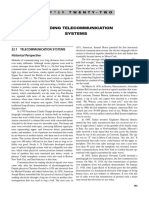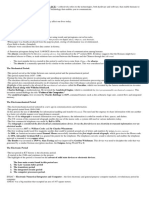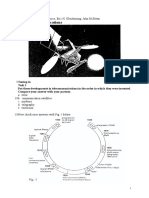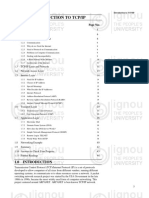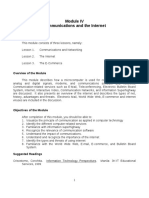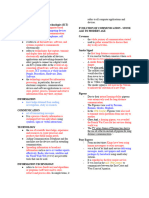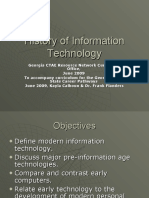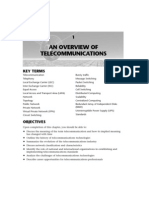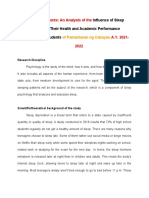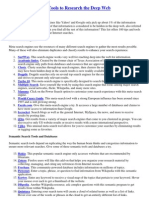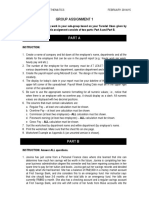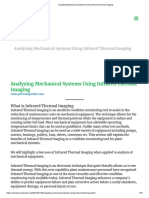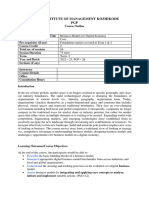0 ratings0% found this document useful (0 votes)
25 views8 pagesMidterms Data Communication
Uploaded by
Ma. Sophia GelveroCopyright
© © All Rights Reserved
We take content rights seriously. If you suspect this is your content, claim it here.
Available Formats
Download as DOCX, PDF, TXT or read online on Scribd
0 ratings0% found this document useful (0 votes)
25 views8 pagesMidterms Data Communication
Uploaded by
Ma. Sophia GelveroCopyright
© © All Rights Reserved
We take content rights seriously. If you suspect this is your content, claim it here.
Available Formats
Download as DOCX, PDF, TXT or read online on Scribd
You are on page 1/ 8
MIDTERMS DATA COMMUNICATION - In 1833, Carl Friedrich Gauss developed
an unusual system based on a five-by-five
HISTORY OF DATA COMMUNICATIONS matrix representing 25 letters (I and J were
Early Communication Methods combined). The idea was to send messages
over a single by deflecting a needle to the
Optical Telegraphs right or left between one and five times. The
- Data Communications began long before initial set of deflections indicated a row, and
recorded time in the form of smoke signals the second set indicated a column.
or tom-tom drums. Soon these methods were Consequently, it could take as many as 10
replaced by flags and later, optical deflections to convey a single character
telegraphs. The Semaphore Telegraph through the system.
System was eventually adopted and widely - Sir Charles Wheatstone and Sir William - In 1840, Morse secured and American patent
implemented all throughout France. At the Cooke Allegedly invented the first for the telegraph, an din 1844 the first
time of French revolution and Napolean telegraph in England, but their contraption telegraph line was established between
prominence, the initial motivation to required six different wires for a single Baltimore and Washington, D.C., with the
implement Semaphore Telegraph System telegraph line. first message conveyed over this system
was military usage, Stations were built 10 – being “What hath God wrought!” in 1849,
15 km apart, operators did not know the the first slow-speed telegraph printer was
exact message, but only relying the symbols invented, but it was not until 1860 that high
which will be decoded at the final receiving speed (15-bps) printers were available. In
station. 1850, Western Union Telegraph company
was formed in Rochester, New York, for the
purpose of carrying coded messages from
one person to another.
Advancements in Technology
- In 1874, Emile Baudot invented a
telegraph multiplexer, which allowed
Morse Telegraphs signals from up to six different telegraph
- The first successful data communications machines to be transmitted simultaneously
system that used electrical signals to over a single wire.
transmit information was invented by - The telephone was invented in 1875 by
Samuel F. B. Morse in 1832 and called the Alexander Graham Bell, and which
- One of the earliest means of telegraph. Morse also developed the first heavily contributed to the slow evolution in
communicating electrically coded practical data communications code, telegraph until 1899, when Guglielmo
information occurred in 1753, when a which is called the Morse Code. With Marconi succeeded in sending radio
proposal submitted to a Scottish magazine telegraphs, dots and dashes (analogous to (wireless) telegraph messages. Telegraph
suggested running a communications line logic 1s and 0s) are transmitted across a wire was the only means of sending information
between villages comprised of 26 parallel using electromechanical induction. Most across large spans of water until 1920, when
wires, each wire for one letter of the common letters could be sent with a single the first commercial radio stations carrying
alphabet. A swiss inventor constructed a symbol (dot for E, dash for T), the other voice information were installed.
prototype of the 26-wire system, but current letters were arranged by frequency and Origin of Computers
making technology proved the idea assigned increasingly complex code. - It is unclear when the first electrical
impractical computer was developed. Konrad Zuis, a
German engineer, demonstrated a computing - The 1970s introduced microprocessor- - In the 1960s, batch-processing systems were
machine sometime in the late 1930s: controlled microcomputers, and by the replaced by on-line processing systems
however, at the time, Hitler was preoccupied 1980s personal computers became an with terminals connected directly to the
trying to conquer the rest of the world, so essential item in the home and workplace. computer through serial or parallel
the project fizzled out. Since then, the number of mainframe communications lines.
- Bell Telephone Laboratories is given computers, small business computers,
credit for developing the first special – personal computers, and computer terminals - The 1970s introduced microprocessor-
purpose computer in 1940 using has increased exponentially, creating a controlled microcomputers, and by the
electromechanical relays for performing situation where more and more people have 1980s personal computers became an
logical operations. However, J. Presper the need (or at least think they have the essential item in the home and workplace.
Eckert and John Mauchley at the University need) to exchange digital information with
of Pennsylvania are given credit by some for each other. Consequently, the need for data - Since then, the number of mainframe
beginning modern-day computing when they communications circuits, networks, and computers, small business computers,
developed the ENIAC computer on February systems has also increased exponentially. personal computers, and computer terminals
14, 1946. - Soon after the invention of the telephone, has increased exponentially, creating a
- In 1949, the U.S. National Bureau of the American Telephone and Telegraph situation where more and more people have
Standards developed the first all-electronic Company (AT&T) emerged, providing both the need (or at least think they have the
diode-based computer capable of executing long-distance and local telephone service need) to exchange digital information with
stored programs. The U.S. Census Bureau and data communications service throughout each other. Consequently, the need for data
in- stalled the machine, which is considered the United States. communications circuits, networks, and
the first commercially produced American - Until 1968, the AT&T operating tariff systems has also increased exponentially.
computer. allowed only equipment furnished by AT&T
- In the 1950s, computers used punch cards to be connected to AT&T lines, but, a
for inputting information, printers for landmark Supreme Court decision, the TRANSMISSION MEDIA AND
outputting information, and magnetic tape Carterfone decision, allowed non-Bell TECHNOLOGIES
reels for permanently storing information. companies to interconnect to the vast AT&T Transmission Media
These early computers could process only communications network. This decision - A transmission medium is a physical path
one job at a time using a technique called started the interconnect industry, which has between the transmitter and the receiver
batch processing. led to competitive data communications i.e. is the channel through which data is sent
- The first general-purpose computer was an offerings by a large number of independent from one place to another. Transmission
automatic sequence-controlled calculator companies. media is broadly classified into the
developed jointly by Harvard University and - In 1983, as a direct result of an antitrust suit following types:
- International Business Machines (IBM) filed by the federal government, AT&T - Types of Transmission Media: Guided
Corporation. The UNIVAC computer, built agreed in a court settlement to divest itself Media and Unguided Media
in 1951 by Remington Rand Corporation, of operating companies that provide basic - Guided Media: twisted pair cable, coaxial
was the first mass-produced electronic local telephone service to the various cable, optical fiber cable, stripline,
computer. geographic regions of the United States. Microstripline
Modern Data Communications Since the divestiture, the complexity of the - Unguided Media: Radiowaves,
- In the 1960s, batch-processing systems were public telephone system in the United States microwaves, infrared
replaced by on-line processing systems with has grown even more in- volved and Metallic Transmission Media
terminals connected directly to the computer complicated. - It refers to the use of conductive materials,
through serial or parallel communications typically copper, to transmit data in the
lines. form of electrical signals. It has been a
traditional choice for various higher-frequency signals, making it a used in older TV antenna setups. The
communications systems, including limiting factor for long-distance and high- continuous dielectric provides better
telephony, networking, and broadcasting. In speed communication over metallic cables. consistency in transmission, reducing
metallic cables, data is transmitted in the - When the signal from one cable interferes interference, but it still lacks the shielding
form of transverse electromagnetic (TEM) with the signal in another cable, especially found in more advanced cables.
waves. These waves consist of oscillating in cases where multiple cables are run - Unshielded Twisted Pair cables consist of
electric (E) and magnetic (H) fields, which closely together, another type of loss known two copper wires twisted around each
propagate through the non-conductive as crosstalk occurs. In twisted-pair cables, other. The twisting helps reduce EMI by
insulating material (dielectric) between the the twisting of the wires helps reduce ensuring that external interference affects
conductors perpendicular to each other and crosstalk, as it minimizes the exposure of the both wires equally, allowing the interference
the direction of wave propagation wires to external interference. Shielded to cancel out. UTP is widely used in
Balanced and Unbalanced Lines cables (STP and coaxial) offer additional telephone networks and Ethernet LANs.
- In a balanced transmission line (e.g., protection against crosstalk by using Categories of UTP are defined by the
twisted pair), both wires carry current, but shielding to block external electromagnetic number of twists per meter, which impacts
in opposite directions. The voltage fields. bandwidth and data transmission rates.
difference between the two wires is the - Electromagnetic Interference (EMI) - Shielded Twisted Pair cables, on the other
signal. The symmetrical nature of balanced occurs when external sources, such as hand, consists of twisted pairs that are
lines helps cancel out external noise, which electrical motors, transformers, or even enclosed in a foil or braided shield that
affects both wires equally. This makes fluorescent lights, create electromagnetic helps further reduce EMI and crosstalk. This
balanced lines more resistant to interference fields that interfere with the signal in a makes STP more resistant to interference
from external sources such as power lines or cable. Shielded cables (STP and coaxial) than UTP, but it is bulkier, more expensive,
radio signals. Twisted-pair cables used in are designed to prevent this type of and harder to install. STP is often used in
Ethernet (UTP or STP) are common interference by enclosing the signal- environments with high interference, such as
examples of balanced lines carrying conductor in a grounded shield. industrial or data center applications.
- In an unbalanced transmission line (e.g., Unshielded cables (e.g., UTP) are more - CAT-3 or Category 3 is a UTP cable used
coaxial cable), one conductor carries the susceptible to EMI, although proper cable for basic telephone lines and older data
signal, while the other conductor installation techniques, such as avoiding networks, supporting speeds up to 10 Mbps.
(typically the shield) is grounded. This power lines, can minimize its effects. - CAT-5 is a UTP cable widely used in
type of line is more prone to noise, Types of Metallic Cables modern Ethernet networks, capable of
especially over long distances, since external - Open-wire transmission lines consist of supporting speeds up to 100 Mbps (Gigabit
interference can affect the single conductor two parallel copper wires separated by air Ethernet).
carrying the signal. However, the shielding or another insulator. Although simple in - CAT-5e is the STP counterpart of CAT-5
in coaxial cables helps mitigate this issue by construction, open-wire systems are which further reduces EMI by wrapping
protecting the inner conductor from external vulnerable to environmental factors like each twisted pair with foil or mesh.
electromagnetic fields. weather and physical interference. The lack - CAT-6 is an improvement over CAT-5, with
Transmission Line Losses of shielding makes them susceptible to higher twists per foot, providing better
- As electrical signals travel through metallic electromagnetic interference (EMI) and resistance to interference and supporting
cables, they lose strength due to the crosstalk, where signals in one wire can speeds up to 10 Gbps.
resistance of the conductor and the interfere with those in adjacent wires. - CAT-6e is the STP counterpart of CAT-6
dielectric. This loss of signal strength is - Twin-lead cables are similar to open-wire, - Coaxial cables consist of a central
called attenuation, and it increases with the but with a solid dielectric insulator conductor surrounded by an insulating layer,
length of the cable and the frequency of the keeping the two conductors at a fixed a metallic shield (typically braided copper or
signal. Attenuation is more pronounced in distance. This type of cable is commonly aluminum), and an outer protective jacket.
The shielding prevents interference from - Optical Fiber Cables, typically made from distances, such as within buildings, data
external sources and helps contain the signal ultra-pure glass or plastic, connect the centers, and campus networks, where cost
within the cable, making coaxial cables transmitter and receiver. In cases of longer and ease of installation are prioritized over
highly efficient for high-frequency distance transmission, repeaters might be long-distance performance.
applications. Coaxial cables were used as buffer to ensure signal strength. Types of multimode fibers:
historically used for Ethernet (10BASE2 Each cable typically includes: o Graded-Index Fibers: The refractive index
and 10BASE5) networks and Cable tv. o Core: The central part where light travels, gradually decreases from the core center
Limitations & Emerging Trends made from high-quality glass or plastic. toward the cladding, reducing modal
- While metallic cables are still widely used, o Cladding: Surrounds the core with a lower dispersion and enhancing performance for
their role is gradually diminishing in favor refractive index material, which helps shorter distances.
of optical fiber due to fiber’s ability to contain light within the core by total internal o Step-Index Fiber: The refractive index has
transmit data at much higher speeds over reflection. a sharp boundary between core and
longer distances without significant signal o Outer Protective Jacket: Provides physical cladding, causing more dispersion, which
loss. Power over Ethernet (PoE) is one protection and strength for handling, makes it less efficient for high-speed, long-
area where twisted-pair cables (like CAT-5e often made of tough polymers or materials distance data transmission
and CAT-6) continue to evolve, as they like PVC. Limitations & Emerging Trends
now support both data and electrical power Light Propagation in Fiber Optics - Optical transmission media, while powerful,
transmission over a single connection to - The idea of sending data over fiber optics is face limitations such as high initial costs,
devices such as cameras, Wi-Fi access only possible through the concept of total fragility, and the need for specialized
points, and IP phones. internal reflection wherein light signals are maintenance due to the delicate nature of
Optical Transmission Media confined within the core of the fiber. When fiber connections. However, emerging
- Optical Transmission Media relies on fiber light strikes the core-cladding boundary at trends are expanding fiber’s capabilities and
optic cables to transmit data as light signals an angle greater than the critical angle, it accessibility. Dense Wavelength Division
rather than electrical signals, making it reflects back into the core, allowing the light Multiplexing (DWDM) significantly
highly advantageous for high-speed, long- signal to travel long distances without increases data capacity by sending multiple
distance communications. Optical fibers, escaping. light wavelengths through a single fiber,
typically made from glass or plastic, have Types of Optical Fiber achieving terabit-level speeds. Fiber-to-the-
transformed telecommunications by o Single-Mode Fiber has a small core (about Home (FTTH) now enables high-speed
enabling enormous data-carrying capacity 8-10 micrometers in diameter) that allows internet and HD streaming directly to
with minimal signal degradation. only a single light path or mode, usually residences, becoming a crucial part of
Parts of Optical Fiber Systems using a laser light source. This is ideal for broadband infrastructure. Additionally,
- A transmitter converts electrical data long-distance communications, such as Plastic Optical Fiber (POF), which is more
signals into light signals, using either an intercity or transcontinental links, due to flexible than glass fiber, is gaining
LED (for MMF) or laser diode (for SMF). It minimal signal dispersion (spreading of light popularity for short-range applications in
includes components such as a voltage-to- pulses). SMF supports very high data rates home networking, electronics, and
current converter and a light source (laser or and is widely used for backbone automotive systems, marking a continued
LED) that encodes data onto the light wave. infrastructure in telecommunications and evolution in optical technology.
- A receiver converts the light signal back internet data centers. Wireless Transmission Media
into an electrical signal. The receiver o Multimode Fiber has a larger core - Wireless transmission media enable the
typically uses a photodetector (like a PIN (typically 50-62.5 micrometers), allowing transmission of electromagnetic waves
diode or an avalanche photodiode) to sense multiple light paths (modes) to travel wirelessly, without the use of a physical
incoming light pulses and convert them to through the core. Its commonly used with medium. While they facilitate the transfer of
electrical pulses. LED light sources and suitable for shorter these waves, they do not control their
direction, hence the name unguided coverage weakens over distance, sender. It decodes and interprets the
transmission media. necessitating boosters or repeaters, incoming data to make it usable. Like the
Radio Waves particularly in remote areas. Emerging sender, receivers can also be computers,
- Radio waves have a frequency range of trends aim to address these challenges, with mobile devices, or other types of electronic
3KHz to 1 GHz and are easy to produce. 5G networks offering faster speeds, lower equipment.
They can travel long distances and are latency, and high capacity for applications 4. Transmission Medium: This refers to the
omnidirectional, meaning they move in all like IoT and smart cities. Wi-Fi 6 and Wi- physical pathway through which data travels
directions. Their ability to penetrate walls Fi 7 enhance performance in crowded areas from sender to receiver. Transmission
makes them ideal for both indoor and by increasing speed and reducing mediums can be classified into two
outdoor communication. Common congestion, while millimeter-wave categories:
applications include AM and FM radio, (mmWave) technology leverages high- a. Guided Media: Includes physical cables
television, cellular phones, and wireless frequency bands to achieve very high data such as twisted pair cables, coaxial cables,
LAN. rates, supporting next-generation mobile and and fiber optic cables.
Microwaves broadband applications. b. Unguided Media: Involves wireless
- Microwaves are electromagnetic waves transmission methods such as radio waves,
with a frequency range of 1 GHz to 300 microwaves, and infrared signals.
GHz and can cover long distances. They are Data Transmission Modes, Protocols & 5. Protocol: Protocols are sets of rules and
unidirectional, meaning they travel in a Standards conventions that govern how data is
straight line. At higher frequencies, they Data Transmission transmitted over a network. They define
cannot pass through walls. Microwaves are - Data transmission refers to the process of aspects such as data format, timing of
commonly used for one-to-one sending and receiving digital or analog data transmissions, error detection and correction
communication, such as in cellular phones, between two or more devices over a methods, and how devices establish
satellite networks, and wireless LAN. communication medium. It encompasses connections with one another. Without
Infrared Waves various methods and technologies that protocols, communication between devices
- Infrared waves are electromagnetic waves enable devices to exchange information would not be possible.
with a frequency range of 300 GHz to 400 effectively. Data Transmission Modes
THz and are limited to short-distance A data transmission system typically Direction of Information Flow,
communication. They rely on line-of-sight consists of five essential components: Synchronization Level, Bit transmission
propagation and cannot pass through solid 1. Message: This is the actual data or Type
objects like walls. A common application of information that needs to be communicated. o Direction of Information Flow
infrared waves is in remote controls for Messages can take various forms, including - The first classification of data transmission
devices such as TVs, DVD players, and text, images, audio, or video files. The modes is based on the direction of
stereo systems. content of the message is critical as it information flow, which plays a crucial role
Limitations and Emerging Trends determines the nature of the communication. in how data is exchanged between devices.
- Wireless transmission media face limitations 2. Sender: The sender is the device or entity There are three primary modes: simplex,
such as restricted bandwidth, increasing that initiates the transmission of the half-duplex, and full-duplex.
congestion as user demands grow, and message. This could be any device capable Simples Mode
susceptibility to interference from obstacles, of sending data, such as a computer, - In simplex mode, communication is
weather, and electronic devices, which can smartphone, or sensor. The sender encodes unidirectional, meaning data flows in only
affect signal quality. Security is also a the message into a format suitable for one direction. This mode is akin to a one-
challenge, as wireless networks are more transmission. way street where the sender transmits data
vulnerable to interception and require strong 3. Receiver: The receiver is the device that without the ability to receive any feedback
encryption protocols. Additionally, wireless receives the transmitted message from the from the receiver. Common examples
include keyboard-to-computer Synchronous Transmission communications. The two primary methods
communication or television broadcasts, - In synchronous transmission, data is sent of bit transmission are serial transmission
where information is sent from the source to in a continuous stream, with both the sender and parallel transmission, each with its
the end-user without any return path. and receiver synchronized by a shared clock unique characteristics, advantages, and
Half-Duplex Mode signal. This synchronization allows for the limitations.
- Half-duplex mode allows for two-way transmission of data in fixed intervals, often Serial Transmission
communication, but not simultaneously; organized into blocks or frames. Because - In serial transmission, data is sent one bit at
only one device can send or receive data at there are no gaps between these blocks, a time over a single communication channel.
a time. This can be likened to a single lane synchronous transmission is typically faster This method can be likened to a single-lane
street where traffic can flow in both and more efficient, making it suitable for road where vehicles (data bits) travel
directions, but only one direction can move high-speed applications such as video sequentially, one after the other. Each bit is
at a time. A practical example of half- conferencing and real-time communications. transmitted in a specific order, often
duplex communication is the use of walkie- The lack of start and stop bits reduces accompanied by start and stop bits to
talkies, where one party must finish overhead, allowing for a more streamlined indicate the beginning and end of the data
speaking before the other can respond. This flow of information. This method is packet. This sequential approach allows for
mode is beneficial in scenarios where particularly advantageous for transferring reliable data transfer over long distances, as
simultaneous communication isn't necessary, large amounts of data quickly, as the it minimizes issues related to timing and
allowing for error detection and continuous nature minimizes latency and synchronization.
retransmission if needed. maximizes throughput. - Serial transmission is commonly used in
Full-Duplex Mode Asynchronous Transmission various protocols such as RS-232 and USB,
- In contrast, full-duplex mode enables - Conversely, asynchronous transmission making it a versatile choice for connecting
simultaneous two-way communication, operates without a shared clock signal, devices across significant distances. While it
allowing both devices to send and receive relying instead on start and stop bits to typically operates at lower speeds compared
data at the same time. This mode indicate the beginning and end of each to parallel transmission, its simplicity and
maximizes efficiency and speed, as it character or byte transmitted. This method reliability make it ideal for applications
utilizes the available bandwidth more allows for irregular intervals between where distance is critical.
effectively. Telephones are a classic characters, which can introduce delays but Parallel Transmission
example of full-duplex communication; both also provides flexibility in communication. - On the other hand, parallel transmission
parties can talk and listen simultaneously Each piece of data is sent independently, sends multiple bits simultaneously across
without waiting for the other to finish. Full- meaning that the sender does not need to multiple channels or wires. This method can
duplex systems are essential in applications wait for the receiver to be ready before be visualized as a multi-lane highway where
requiring real-time interaction, such as video sending the next byte. While this can lead to several vehicles (data bits) can travel side by
conferencing or online gaming. increased latency due to the time gaps side at the same time. For instance, an 8-bit
o Synchronization Level between transmissions, asynchronous byte can be transmitted in one go using eight
- The concept of synchronization levels in transmission is simpler to implement and separate wires. This simultaneous transfer
data transmission is crucial for more cost-effective, making it suitable for allows for much faster data rates compared
understanding how data is effectively applications like email or keyboard input to serial transmission, making parallel
communicated between devices. This can be where speed is less critical. communication suitable for short-distance
categorized primarily into synchronous and o Bit Transmission Type applications where speed is essential, such
asynchronous transmission, each with - Understanding bit transmission types is as within computer systems or between
distinct characteristics that affect the essential for grasping how data is closely located devices. However, parallel
efficiency and reliability of data transfer. communicated between devices, particularly transmission comes with its challenges; as
- in the context of digital and data the distance increases, signal degradation
and timing issues can arise due to the need during transmission. This is vital for everything from physical connections to data
for all bits to arrive simultaneously. This maintaining data integrity and ensuring that link layer protocols, ensuring that devices
makes parallel transmission less reliable the information received matches what was can communicate over both wired and
over long distances. originally sent. wireless networks.
o Protocols - Numerous protocols exist to facilitate o ISO
- Protocols in data communication are different types of communication. For - Another significant body is the
essential frameworks that establish the rules instance, the Transmission Control International Organization for
and conventions governing how data is Protocol/Internet Protocol (TCP/IP) Standardization (ISO), which develops
transmitted between devices in a network. ensures reliable transmission by establishing international standards across various
These protocols ensure that communication a connection-oriented communication industries, including networking. The
is effective, reliable, and standardized across channel that guarantees delivery through ISO/IEC 7498-1 standard outlines the
diverse systems. At their core, protocols acknowledgments and retransmissions. In Open Systems Interconnection (OSI)
define several critical aspects of data contrast, the User Datagram Protocol model, a conceptual framework that
exchange, including what information is to (UDP) allows for faster communication by standardizes the functions of a
be communicated, how it should be sending messages without establishing a telecommunication or computing system
formatted, and when it should be sent. connection first, making it suitable for into seven layers. This model helps in
o Syntax applications where speed is more critical understanding how different networking
- One of the primary functions of a protocol is than reliability. protocols interact and ensures that systems
to specify the syntax of the data being o Standards from different manufacturers can work
transmitted. This includes the structure or - Standards in Networking are critical together.
format of messages, ensuring that both the frameworks that ensure interoperability, o OSI Model
sender and receiver understand how to reliability, and efficiency in data - The ISO/IEC 7498-1 standard, commonly
interpret the bits being exchanged. For communication across various devices and known as the Open Systems
example, protocols dictate whether data is networks. These standards are established by Interconnection (OSI) model, serves as a
sent as plain text, binary code, or in specific recognized organizations and serve as foundational framework for understanding
file formats like JPEG or MP3. Additionally, guidelines that define the technical and implementing network communication.
protocols encompass semantics, which requirements, specifications, and protocols The OSI model is structured into seven
provide meaning to the various sections of necessary for devices to communicate layers, which are organized hierarchically
data packets. This ensures that both parties effectively. By adhering to these standards, from the lowest physical layer to the highest
can accurately interpret the information manufacturers can create products that work application layer. The Physical Layer
being shared. seamlessly together, regardless of the (Layer 1) deals with the transmission of raw
o Timing vendor, which is essential in today’s diverse bitstreams over a physical medium,
- Timing is another critical element governed technological landscape. including specifications for cables, switches,
by protocols. They establish rules for when o IEEE and electrical signals. The Data Link Layer
data can be sent and how quickly it should - The Institute of Electrical and Electronics (Layer 2) is responsible for node-to-node
be transmitted. This aspect is particularly Engineers (IEEE) is one of the most data transfer and error detection and
important in real-time applications such as prominent organizations responsible for correction, ensuring that data packets are
video conferencing or online gaming, where developing networking standards. For transmitted accurately between directly
delays can significantly impact user instance, the IEEE 802 series defines connected devices. Above this, the Network
experience. Protocols also incorporate standards for local area networks (LANs), Layer (Layer 3) manages routing and
mechanisms for error detection and including the widely used IEEE 802.3 for forwarding of data packets across multiple
correction, enabling devices to identify and Ethernet and IEEE 802.11 for wireless networks, determining how data should be
rectify any discrepancies that may occur LANs (Wi-Fi). These standards specify sent from source to destination.
applications can communicate over the
internet reliably.
- The Transport Layer (Layer 4) ensures
complete data transfer and provides error
recovery and flow control mechanisms. It
segments messages into smaller packets for
transmission and reassembles them at the
destination. The Session Layer (Layer 5)
establishes, manages, and terminates
sessions between applications, handling
communication sessions effectively. The
Presentation Layer (Layer 6) translates
data formats, encrypts information for
secure transmission, and ensures that data is
presented in a readable format for the
application layer. Finally, the Application
Layer (Layer 7) interfaces directly with
end-user applications, providing network
services such as file transfers and email
communication.
o TIA and IETF
- The Telecommunications Industry
Association (TIA) also plays a vital role in
setting standards related to
telecommunications cabling and equipment.
Standards such as TIA-568 govern
structured cabling systems, ensuring
compatibility among different
manufacturers’ equipment and facilitating
efficient data transmission in both
commercial and residential settings.
- Furthermore, the Internet Engineering
Task Force (IETF) is instrumental in
developing standards specifically for
internet protocols. The IETF’s Request for
Comments (RFC) documents outline
protocols like the Transmission Control
Protocol (TCP) and Internet Protocol (IP),
which form the backbone of internet
communication. These documents are
crucial for ensuring that data packets are
routed correctly across networks and that
You might also like
- Introduction To Data Communications and Networking: Chapter Outline100% (1)Introduction To Data Communications and Networking: Chapter Outline27 pages
- Chapter 21 - Introduction To Data Communications and NetworkingNo ratings yetChapter 21 - Introduction To Data Communications and Networking3 pages
- Data Communications - PPTX Chapter 1 V1No ratings yetData Communications - PPTX Chapter 1 V131 pages
- ECE 512L Data Communication: Engr. Adriano Mercedes H. Cano JRNo ratings yetECE 512L Data Communication: Engr. Adriano Mercedes H. Cano JR92 pages
- Chapter 1 Introdution To Data CommunicationNo ratings yetChapter 1 Introdution To Data Communication10 pages
- Chapter 21: Introduction To Data Communications and Networking - Review NotesNo ratings yetChapter 21: Introduction To Data Communications and Networking - Review Notes13 pages
- EEE 437: Telecommunications Engineering: Prof. Kazi Mohiuddin Ahmed Fall Semester, 2016No ratings yetEEE 437: Telecommunications Engineering: Prof. Kazi Mohiuddin Ahmed Fall Semester, 201639 pages
- Fundamentals of Electronics CommunicatioNo ratings yetFundamentals of Electronics Communicatio22 pages
- Year Breakthrough Remarks: Introduction To Digital CommunicationsNo ratings yetYear Breakthrough Remarks: Introduction To Digital Communications8 pages
- TOPIC 4 Introduction To Communication Technology INo ratings yetTOPIC 4 Introduction To Communication Technology I7 pages
- Chapter 8 - INFORMATION AGE Part 2 of 4No ratings yetChapter 8 - INFORMATION AGE Part 2 of 421 pages
- Module 1 Information and Communications TechnologyNo ratings yetModule 1 Information and Communications Technology2 pages
- Snapshot of Telecommunication Industry:-: HistoryNo ratings yetSnapshot of Telecommunication Industry:-: History5 pages
- Introduction To Data Communications SystemNo ratings yetIntroduction To Data Communications System10 pages
- REVIEWER in Electronic Communications System by Wayne TomasiNo ratings yetREVIEWER in Electronic Communications System by Wayne Tomasi112 pages
- REVIEWER in Electronic Communications System by Wayne Tomasi100% (2)REVIEWER in Electronic Communications System by Wayne Tomasi112 pages
- Communications and The Internet: Scope of The ModuleNo ratings yetCommunications and The Internet: Scope of The Module27 pages
- FS - 5.1 - History of Information Technology - KCNo ratings yetFS - 5.1 - History of Information Technology - KC14 pages
- Introduction To Electronic CommunicationsNo ratings yetIntroduction To Electronic Communications33 pages
- Formula Depreciation and After Annd Before TaxNo ratings yetFormula Depreciation and After Annd Before Tax1 page
- 100 Useful Tips and Tools To Research The Deep Web100% (1)100 Useful Tips and Tools To Research The Deep Web5 pages
- A Case Study On The Different Major Players of Fuel Oil in The PhilippinesNo ratings yetA Case Study On The Different Major Players of Fuel Oil in The Philippines6 pages
- F2 Chapter 10 (Foreign Currency Transactions)No ratings yetF2 Chapter 10 (Foreign Currency Transactions)5 pages
- Sample: Session 3 Extension Activity: Advanced Cropping TechniquesNo ratings yetSample: Session 3 Extension Activity: Advanced Cropping Techniques3 pages
- o Levelcomputer Ruknuddin Patels Web PortalNo ratings yeto Levelcomputer Ruknuddin Patels Web Portal29 pages
- 4 - ITU Standards and Network Deployment Guidelines100% (5)4 - ITU Standards and Network Deployment Guidelines87 pages
- Business Math Payroll & Finance AssignmentNo ratings yetBusiness Math Payroll & Finance Assignment4 pages
- Infrared Thermal Imaging for Mechanical SystemsNo ratings yetInfrared Thermal Imaging for Mechanical Systems16 pages



















